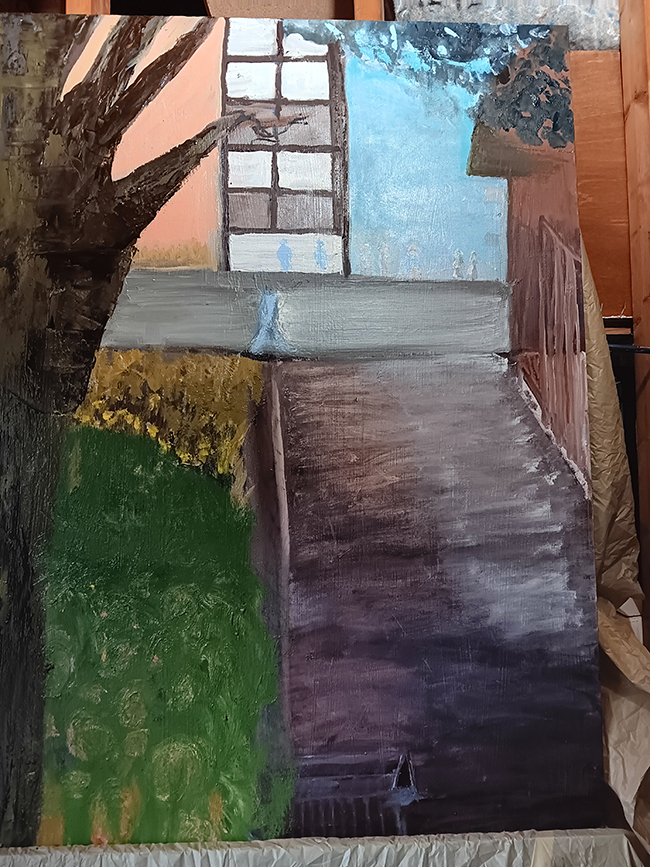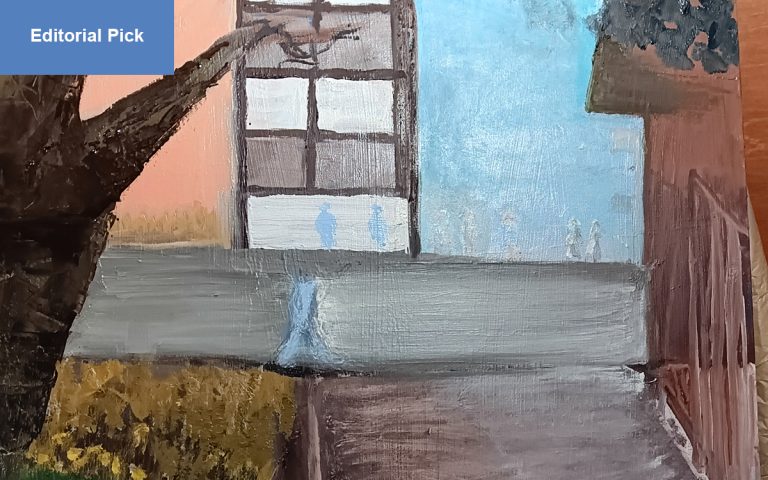Martin Collier, who also goes by Marcol from ArtistAffect, is an artist who doesn’t stop at painting—he digs into the very pigments that make the work possible. His practice is as much about material as it is about image. When a supplier left him waiting with no answers about an order, he didn’t just shrug it off. Instead, he took the plunge into making his own oil paints from raw pigment. That step speaks volumes. It wasn’t just about frustration—it was about wanting control, wanting to understand every layer of what goes onto the canvas. Collier approaches art this way: with curiosity, persistence, and an insistence on knowing the ground beneath his feet. His paintings come out of that blend of research and intuition, each one a kind of experiment in both vision and process.

A Look at the Work
The painting at hand is a study in contrast, balance, and atmosphere. At first glance, you’re drawn to the sense of depth it creates—the pathway stretching upward, leading the eye toward a bright architectural form and the hazy silhouettes beyond. The canvas feels split between shadow and light, a play between the heavy, earthy tones in the foreground and the pale, airy wash of the sky.
The tree on the left takes up a dominant position. Its branches cut across the lighter backdrop, anchoring the piece and giving it weight. Below it, the brushwork shifts: greens dense with texture, dotted with yellowish strokes that hint at leaves or flowers. The treatment here is rough, layered, almost tactile, as though Collier wanted to leave evidence of the brush itself.
On the right, a sloping path rises, painted in muted browns and grays. There’s a subtle rhythm in the way the strokes move diagonally upward, carrying you toward the upper half of the composition. The sense of direction is deliberate. You’re pulled forward, invited into the structure that looms at the top. That structure, with its grid-like framing, contrasts starkly with the more organic sections of the painting. It feels man-made, rigid, measured. Through its panels of pale color, faint figures emerge. They’re no more than hints, silhouettes in soft blue and beige, but they add life to the scene. They suggest motion, a public space, maybe a memory of a street or courtyard where people pass by.
Above, the sky is a transition—moving from a warm peach on the left to a cool blue on the right. This shift isn’t just background filler; it’s mood. The peach warms the tree and the left side of the work, while the blue cools the right side, heightening the contrast between natural and built elements.
What makes this painting compelling isn’t polish or perfection—it’s the rawness of its parts. You can see where layers overlap, where texture shifts suddenly, where colors resist blending. It reads like a work in progress, but that quality gives it energy. The painting becomes a record of decisions, of moments when Collier pressed pigment into the canvas and let it settle.
Seen in the context of Collier’s process, the work connects back to his fascination with pigment itself. Knowing that he sometimes makes his own paints, you can almost feel the weight of that decision here. The earthy greens and browns don’t look store-bought—they look worked, adjusted, tested. The blues in the background glow with a softer, almost handmade quality. There’s a sense that Collier isn’t just painting a scene, but testing what his materials can do in the space of that scene.
Thematically, the painting sits between observation and interpretation. It hints at place—trees, a building, a street—but it doesn’t lock into realism. Instead, it hovers between memory and abstraction. The faint people in the distance could be there, or they could be ghosts of thought, fragments that belong as much to the act of painting as to the subject itself.
What lingers is the sense of atmosphere. This isn’t a simple depiction of a path and a structure. It’s a meditation on light, form, and material. It shows Collier’s eye for layering—not just with paint, but with meaning. A tree, a building, a path: ordinary elements, but rearranged and reimagined in a way that asks the viewer to pause.
In the end, this painting is as much about process as it is about place. It’s about the journey from raw pigment to finished surface, about what happens when an artist insists on knowing his materials inside out. Collier’s work is grounded in this curiosity, and this piece stands as an example of how exploration and craft come together—not smoothly, but honestly, in layers of color and thought.

